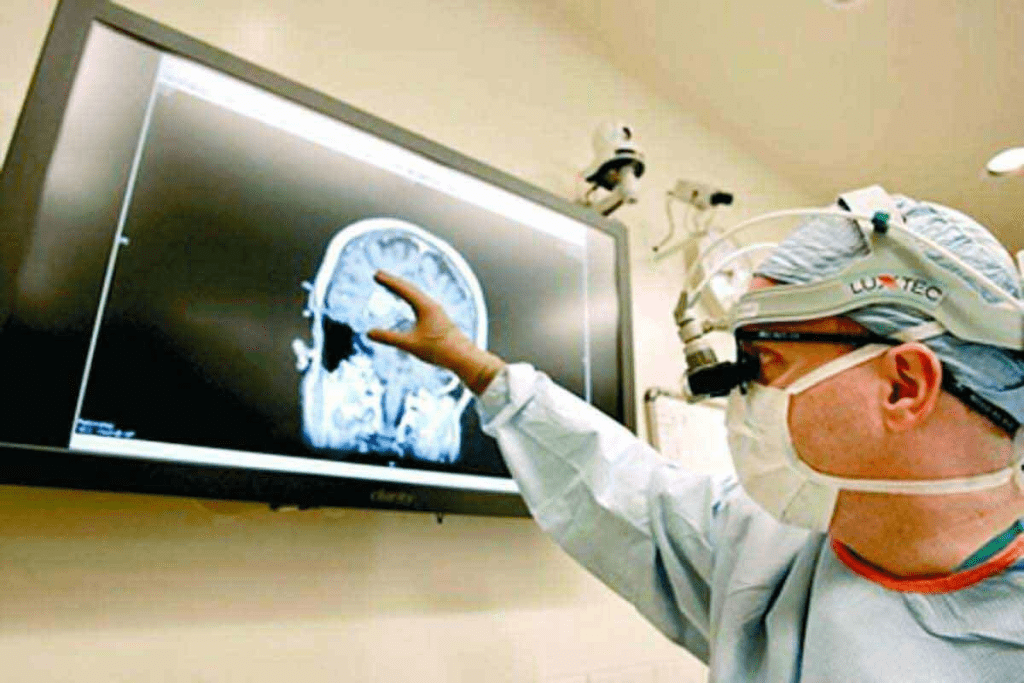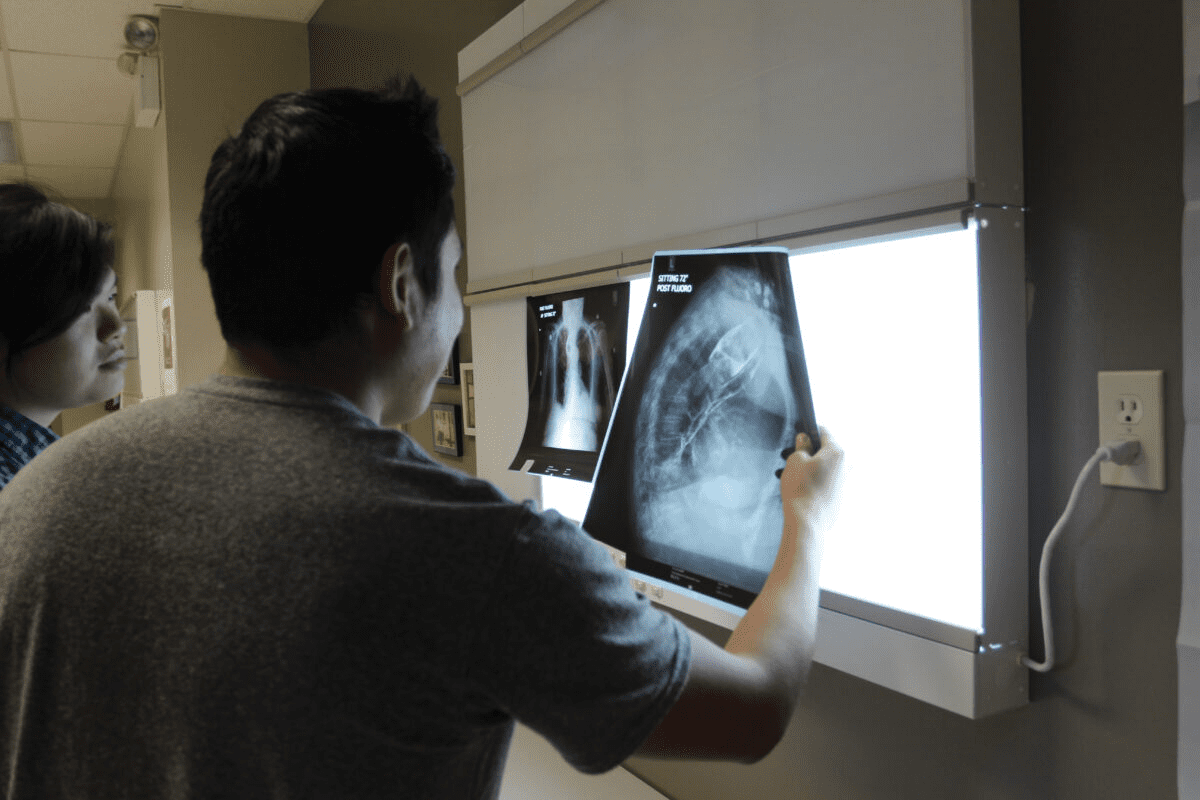Last Updated on November 27, 2025 by Bilal Hasdemir

Medical technology has made big strides in brain cancer treatment, bringing new hope to those diagnosed with brain tumors. At Liv Hospital, we understand how tough a diagnosis can be. Our team offers personalized care, using the newest brain cancer treatment and brain tumor management methods to ensure the best possible outcomes for every patient.
Medical research is moving fast, making treatment options for brain cancer better and more effective. We aim to give top-notch healthcare. We also offer full support to our international patients, helping them on their path to recovery.
Key Takeaways
- Personalized care for brain cancer patients
- Latest therapies and breakthroughs in brain tumor management
- Advanced treatment options for improved patient outcomes
- Comprehensive international patient support
- World-class healthcare delivery at Liv Hospital
Understanding Brain Cancer and Its Impact

Brain cancer is complex, with over 150 types of tumors. Each type has its own challenges. It’s important to understand the different forms and how they are diagnosed.
Types of Brain Tumors and Their Characteristics
Brain tumors are either benign or malignant. Benign tumors, like many meningiomas, are usually non-cancerous. Malignant tumors, like glioblastomas, are cancerous and harder to treat.
Some tumors grow slowly, while others grow fast. Where the tumor is in the brain affects symptoms and treatment.
Diagnosis and Staging Process
Diagnosing brain cancer uses MRI and CT scans, and a biopsy to confirm the tumor type. The staging process shows how far the tumor has spread. This is key to choosing the right treatment.
Getting an accurate diagnosis and staging is vital for a good treatment plan. New diagnostic technologies help doctors tailor treatments to each patient.
Factors Affecting Treatment Selection
Choosing a treatment for brain cancer depends on several factors. These include the tumor’s type, stage, location, and the patient’s health. Treatment plans are made to fit each patient’s needs.
Innovative treatments, like electric field therapy, may offer new hope. These are part of the ongoing research into advanced brain cancer treatment options.
Historical Approaches to Treating Brain Tumors
Brain tumor treatment has come a long way. From early surgeries to today’s multi-modal treatments. Knowing the history helps us see how far we’ve come.
New brain tumor treatment options are being researched. Studies are looking into new therapies and treatment combinations.
Surgery: The Cornerstone of Brain Cancer Treatment

Surgery is key in treating brain cancer, thanks to new tech. It has made brain surgery safer and more precise.
Surgery plays a big role in treating brain tumors. It’s often the first step, helping diagnose and relieve symptoms. It also gives tissue samples for further study.
Advanced Surgical Techniques
Modern surgery uses new methods to improve results. Neuronavigation helps find tumors and navigate the brain. MRI and CT scans give live images during surgery, helping remove tumors better.
Robotic surgery is another big step forward. It gives surgeons better control and vision. This leads to more detailed surgeries with fewer problems.
| Technique | Description | Benefits |
| Neuronavigation | Precise location of tumors and navigation through brain anatomy | More accurate tumor removal |
| Intraoperative MRI/CT | Real-time imaging during surgery | Enhanced precision, potentially fewer complications |
| Robotic-Assisted Surgery | Enhanced dexterity and visualization | Increased precision, potentially reduced recovery time |
Awake Craniotomy and Brain Mapping
Awake craniotomy keeps patients awake during surgery. This lets surgeons map brain functions live. It helps avoid harming important areas.
Brain mapping is vital for surgeries near vital functions. Keeping patients awake lets surgeons test these functions. This ensures the brain’s important parts are safe.
Minimally Invasive Surgical Approaches
Minimally invasive surgery has changed brain surgery. It uses small incisions, reducing risks. Endoscopic surgery uses a small camera and tools through tiny openings.
These methods cut down recovery time and scarring. As tech gets better, so will these surgeries.
Using these advanced techniques and careful planning, we can greatly improve brain cancer treatment. This leads to better outcomes for patients.
Radiation Therapy: Precision Targeting of Brain Tumors
Radiation therapy is a key treatment for brain cancer. It offers hope and precision to patients globally. We use advanced methods to target tumors, protecting healthy tissue.
External Beam Radiation Therapy
External beam radiation therapy (EBRT) is a common treatment for brain cancer. It uses high-energy X-rays or photons from outside the body. EBRT is highly effective for treating various types of brain tumors, including glioblastoma, meningioma, and acoustic neuroma.
Technologies like intensity-modulated radiation therapy (IMRT) and stereotactic radiosurgery (SRS) have improved EBRT’s precision. IMRT shapes the radiation beams to fit the tumor. SRS delivers a focused dose in one session or a few fractions.
Proton Therapy for Brain Cancer
Proton therapy uses protons instead of X-rays to kill cancer cells. This technique is beneficial for tumors near critical brain structures, as it controls the radiation dose precisely.
“Proton therapy represents a significant advancement in radiation oncology, improving quality of life for brain cancer patients.” – A Radiation Oncologist
Proton therapy delivers a high dose to the tumor while sparing healthy tissue. It’s a good option for certain brain tumors, like those in children or near critical areas.
We keep improving radiation therapy, including proton therapy, to better treat brain cancer. By combining these treatments with surgery and chemotherapy, we offer personalized care for each patient.
Chemotherapy and Drug Therapies for Brain Cancer
Chemotherapy and drug therapies have made a big difference in treating brain cancer. We’re always looking for better ways to help patients. Chemotherapy is a key part of treatment for many.
Standard Chemotherapy Protocols
Chemotherapy for brain cancer uses drugs that target fast-growing cells. Temozolomide is often used for glioblastoma. It’s usually combined with surgery and radiation therapy.
“Chemotherapy is a big help in treatment,” says Dr. Jane Smith, a top oncologist. “But how well it works depends on the tumor and the patient’s health.”
Blood-Brain Barrier Challenges
The blood-brain barrier (BBB) is a big challenge in treating brain cancer. It keeps many substances, including drugs, out of the brain. This makes it hard for chemotherapy to reach the tumor.
Novel Drug Delivery Methods
To get past the BBB, scientists are trying new ways to deliver drugs. These include:
- Convection-enhanced delivery, which infuses drugs directly into the tumor.
- Nanoparticle-based delivery systems that can get past the BBB.
- Focused ultrasound, which temporarily opens the BBB for drug delivery.
These new methods aim to get chemotherapy drugs to brain tumors better. This could make treatments more effective and reduce side effects.
We’re always working to improve chemotherapy and drug therapies for brain cancer. By using both old and new methods, we can offer better care for our patients.
Immunotherapy: Harnessing the Body’s Defenses
Immunotherapy is changing how we treat brain cancer. It uses the body’s immune system to target cancer cells. This can help protect healthy tissue around the tumor.
Recent studies have shown great promise in treating brain tumors like glioblastoma. New strategies include checkpoint inhibitors, CAR-T cell therapy, and cancer vaccines. These methods aim to boost the body’s fight against cancer.
CAR T-Cell Therapy Applications
CAR T-cell therapy is a type of immunotherapy. It takes T cells from the blood, changes them to find cancer cells, and then puts them back. This method has shown great promise in treating blood cancers and is being tested for brain cancer too.
- Targeted approach: CAR T-cell therapy can be made to target specific proteins on cancer cells.
- Personalized treatment: The therapy is customized for each patient, making it more effective.
- Ongoing research: Studies are being done to see how safe and effective CAR T-cell therapy is for brain cancer.
Vaccine-Based Approaches
Vaccine-based immunotherapy for brain cancer uses vaccines to get the immune system to fight cancer cells. These vaccines can be made from the patient’s tumor cells or specific proteins found in brain cancer.
- Stimulating an immune response: The vaccine helps the immune system see cancer cells as invaders.
- Combining with other treatments: These approaches can be used with other therapies like surgery or chemotherapy.
- Ongoing development: Researchers are always working on new vaccine-based therapies for brain cancer.
As we learn more about immunotherapy for brain cancer, we’re hopeful. We believe these new methods will improve patient outcomes and quality of life.
Breakthrough Technologies in Brain Cancer Treatment
The field of brain cancer treatment is changing fast. New technologies are showing great promise. These advancements are changing how we treat brain cancer, leading to better results for patients.
Tumor Treating Fields (TTFields)
Tumor Treating Fields (TTFields) is a new way to fight cancer. It uses electrical fields to stop cancer cells from growing. This method is effective against some brain cancers, like glioblastoma.
Key benefits of TTFields include:
- It’s non-invasive, meaning no surgery is needed.
- It has fewer side effects than traditional treatments.
- It can be used with other treatments.
Fusion Superkine Molecules
Fusion superkine molecules are another new tool in fighting brain cancer. They are made to target cancer cells, harming them while protecting healthy cells. These molecules combine different treatments into one powerful attack.
The power of fusion superkine molecules is in their:
- Specific targeting of cancer cells.
- Ability to trigger strong anti-tumor responses.
- Potential to overcome cancer resistance.
Targeted Molecular Therapies
Targeted molecular therapies are changing brain cancer treatment. They focus on the unique traits of each tumor. These therapies aim to stop cancer cells from growing while keeping normal cells safe.
Advantages of targeted molecular therapies include:
- They are tailored to each patient’s tumor.
- They are more effective with fewer side effects.
- They can help when other treatments fail.
Gene Therapy Approaches
Gene therapy is a new area in brain cancer treatment. It involves changing genes to stop cancer cells from growing. This can lead to cell death or boost the immune system’s fight against cancer.
Gene therapy offers hope for:
- Fixing genetic mistakes that cause cancer.
- Improving how well other treatments work.
- Offering long-term or even cure-like solutions.
Personalized Medicine and Brain Tumor Management
Personalized medicine is changing how we treat brain cancer. It tailors treatments to fit each patient’s needs. This new approach is key in managing brain tumors, giving hope to those with tough cases.
Genomic Profiling and Precision Oncology
Genomic profiling leads the way in personalized medicine for brain tumors. It looks at a tumor’s genes to find mutations that make it grow. This helps pick treatments that are more likely to work.
Precision oncology uses advanced tech to understand each tumor’s unique traits. It helps create treatment plans that match the tumor’s genetic and molecular features.
Biomarker-Driven Treatment Selection
Biomarkers are key in personalized medicine. They help find who will benefit most from certain treatments. In brain tumors, biomarkers guide how to treat and predict how well a treatment will work.
- Identifying MGMT promoter methylation status to predict response to temozolomide
- Detecting IDH1/2 mutations to guide targeted therapy selection
- Assessing 1p/19q codeletion status to inform prognosis and treatment planning
Adaptive Treatment Protocols
Adaptive treatment plans are vital in personalized medicine for brain tumors. They adjust treatment based on how the patient responds and changes in the tumor.
| Treatment Phase | Assessment Criteria | Adaptive Strategy |
| Induction | Tumor response, toxicity | Adjust chemotherapy dosage or switch to alternative regimen |
| Maintenance | Disease progression, side effects | Modify treatment schedule or introduce new agents |
| Relapse | Tumor genetics, previous treatments | Implement salvage therapy or clinical trial participation |
By using personalized medicine, we can offer better treatments for brain tumor patients. This improves their outcomes and quality of life.
Supportive Care and Quality of Life Considerations
Brain cancer affects more than just the tumor. It impacts patients and their families deeply. As we work to improve treatments, we must also focus on patients’ overall well-being.
Supportive care helps patients deal with the physical, emotional, and social challenges of brain cancer. It improves their quality of life.
Managing Treatment Side Effects
Managing side effects is key in supportive care. Treatments like surgery, radiation, and chemotherapy can cause fatigue, nausea, and cognitive changes.
Healthcare teams use many strategies to help. This includes:
- Medication to control symptoms like nausea and seizures
- Physical therapy to maintain strength and mobility
- Occupational therapy to support daily functioning
- Nutritional counseling to ensure adequate nutrition
Neurological Rehabilitation
Neurological rehabilitation is vital for recovery. It involves a team of specialists like neurologists and physical therapists.
The goals include:
- Restoring lost functions or compensating for them
- Improving cognitive abilities affected by treatment
- Enhancing overall quality of life
Rehabilitation plans are made for each patient. They may include cognitive training and physical therapy.
Psychological Support for Patients and Families
Brain cancer can deeply affect patients and their families. Psychological support is essential for care.
Support services include:
- Individual and family counseling
- Support groups for patients and caregivers
- Mental health services to address anxiety, depression, and other concerns
These services help patients and families face emotional challenges. They improve well-being and resilience.
In conclusion, supportive care is vital for brain cancer management. It focuses on managing side effects, rehabilitation, and psychological support. This improves the quality of life for patients and their families.
Conclusion: The Future of Brain Cancer Treatment
We’ve seen big steps forward in treating brain cancer, giving hope to those affected. New therapies like Fusion Superkine molecules and Tumor Treating Fields are showing great promise. They’ve had positive results in early tests.
New ways to deliver treatments, like focused ultrasound, are on the horizon. This could make treatments safer and more precise. Researchers are working hard to use these new methods in real patients. This could lead to a cure for brain cancer.
We’re committed to advancing medical science to help brain tumor patients. The goal of better treatments and a cure is getting closer. We’re working hard to make this vision a reality.
FAQ
What are the latest therapies and breakthroughs in brain cancer treatment?
We’ve seen big steps forward in treating brain cancer. New methods in surgery, radiation, and chemotherapy are helping. Immunotherapy and targeted treatments are also making a difference. These advances are improving how patients live and feel.
How are brain tumors diagnosed and staged?
Doctors use MRI and CT scans to find brain tumors. They also take a biopsy. By knowing the tumor’s type and how far it’s spread, they can plan the best treatment.
What factors affect treatment selection for brain cancer?
Many things influence how we treat brain cancer. The tumor’s type, size, and where it is matter. So does the patient’s health and what they want. We use all this information to make a treatment plan just for them.
What is the role of surgery in brain cancer treatment?
Surgery is often the first step in treating brain cancer. It aims to remove as much of the tumor as possible. New techniques, like awake craniotomy, help doctors do this safely.
How does radiation therapy work in treating brain cancer?
Radiation therapy uses beams to kill cancer cells. There are different types, like external beam and proton therapy. These methods are precise and can reduce side effects.
What are the challenges of chemotherapy in brain cancer treatment?
Chemotherapy can be hard to get into brain tumors because of the blood-brain barrier. We’re looking into new ways to get drugs past this barrier. This could make chemotherapy more effective.
Can immunotherapy be used to treat brain cancer?
Yes, immunotherapy is showing promise for brain cancer. It uses the body’s immune system to fight cancer. CAR T-cell therapy and vaccines are being studied for their effectiveness.
What is personalized medicine in brain tumor management?
Personalized medicine means tailoring treatment to each patient. This includes looking at their genes and biomarkers. It helps us create treatments that are just right for them.
How can brain cancer patients manage treatment side effects?
We offer support to help with side effects. This includes rehab, psychological help, and managing symptoms. Our goal is to improve patients’ quality of life.
Can brain tumors be cured?
Whether a brain tumor can be cured depends on several things. The type, grade, and stage of the tumor matter. So does how well the treatment works. We work with patients to find the best treatment plan.
What are the benefits of advanced brain cancer treatment options?
New treatments like TTFields and targeted therapies offer better results. They also have fewer side effects. This means patients can live better lives.
How do we treat brain cancer using gene therapy approaches?
Gene therapy changes or replaces genes to treat disease. It’s being explored for brain cancer. This approach could lead to better outcomes for patients.
References
- Salahlou, R., Farajnia, S., Alizadeh, E., et al. (2025). Recent developments in peptide vaccines against Glioblastoma, a review and update. Molecular Brain, 18, Article 50. https://molecularbrain.biomedcentral.com/articles/10.1186/s13041-025-01221-x






